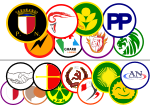Prime Minister of Malta: Difference between revisions
Undid revision 311311356 by 174.117.171.216 (talk) |
Vassallo5448 (talk | contribs) m addition to external links. |
||
| Line 59: | Line 59: | ||
{{reflist}} |
{{reflist}} |
||
==External Links== |
|||
*[http://www.maltagenealogy.com/libro%20d'Oro/politics.html Prime Ministers of Malta genealogies] |
|||
Revision as of 12:43, 19 October 2009
| Prime Minister of the Republic of Malta | |
|---|---|
 Coat of Arms of the Republic of Malta | |
since 10 March 2008 | |
| Style | The Honourable |
| Appointer | Edward Fenech Adami as the Head of State |
| Term length | General Elections are held every five years at a maximum, but may be held sooner. The Prime Minister is by convention the leader of the victorious party. No term limits are imposed on the office. |
| Inaugural holder | Joseph Howard |
| Formation | 1921 |
| Website | https://opm.gov.mt/ |
 |
|---|
The Prime Minister of Malta is the head of the executive branch of the Republic of Malta. The Prime Minister is the Head of Government assisted by his cabinet in day to day running of the country and a minister in his own right. [1]
Establishment of the Office and Developments
Before World War II
At the time when Malta was a British colony, home rule was refused to the Maltese until 1921 although a partly elected legislative council was created as early as 1849. It was only after the riots in 1919 and the resulting deaths of four native students that eventually lead to greater autonomy for the Maltese. This resulted in the 1921 constitution which granted a considerable measure of self-government. Political tensions reemerged, and the constitution, after having twice been suspended, was revoked in 1936. A new constitution in 1939 reinstated Malta as a British crown colony.
After World War II
Substantial self-government was restored in 1947. After the 1956 failed Referendum regarding UK Integration pressure started to mount on the government led by then Prime Minister Dom Mintoff. Following the breakdown of talks between Valletta and Whitehall regarding the integration of Malta in 1958. The Government resigned and direct British colonial rule over Malta was reinstated. Although a year later an Interim Constitution was granted to Malta which provided for the creation of an Executive Council. It was only in 1962 that self-government was reattained through a new constitution. The Maltese, carried out negotiations with the UK for complete self-government, except in matters of defense and foreign affairs. In August 1962, Prime Minister Borg Olivier requested the UK to grant Malta independence, and Malta became a sovereign and independent nation within the Commonwealth of Nations on 21 September 1964. On 13 December 1974, Malta formally adopted a republican form of government.
Constitutional Functions
The Prime Minister is appointed by the President of Malta, with the President making his or her decision based on the situation within the Maltese parliament. A Prime Minister must command a majority of the votes in parliament to hold office.
The Prime Minister is responsible for assigning departments of government to Permanent Secretaries. According to the Constitution of Malta the Prime Minister of Malta shall keep the President of Malta fully informed concerning the general conduct of the Government of Malta and shall furnish the President of Malta with such information as he may request with respect to any particular matter relating to the Government of Malta.
Whenever the Prime Minister is absent from Malta or on vacation, or is unable by reason of illness to perform the functions of his office, the President may authorise any other member of the Cabinet to perform those functions and that member may perform those functions until his authority is revoked by the President.
Office of the Prime Minister of Malta (OPM)
Since 1972 Auberge de Castille in Valletta has housed the office of the Prime Minister of Malta. The OPM is the hub and nerve centre of the Government of Malta. It plays a central role in decision-making and it is also the administrative headquarters of the Government.
The Office of the Prime Minister, commonly known as OPM or simply "Kastilja". OPM's mission is to support the Prime Minister in providing leadership and direction for a stable and effective government. The departments and units constituting OPM have changed considerably over the years. However, there has been a stable core such as the Cabinet Secretariat, the Management and Personnel Office (known as Establishments Division prior to 1990) and the Department of Information. Currently there are over 300 staff in the Office of the Prime Minister. Additionally there are 1,500 personnel on the AFM books which also forms part of the OPM portfolio.
Girgenti Palace
Girgenti Palace is the official residence of the Prime Minister's of Malta however it is not widely used. [2]
See also
- List of Prime Ministers of Malta
- President of Malta
- Government of Malta
- House of Representatives of Malta


